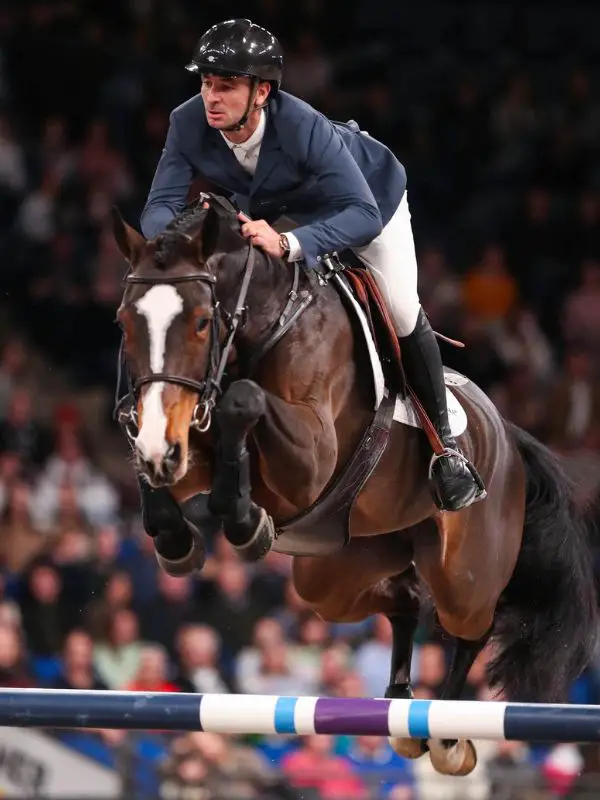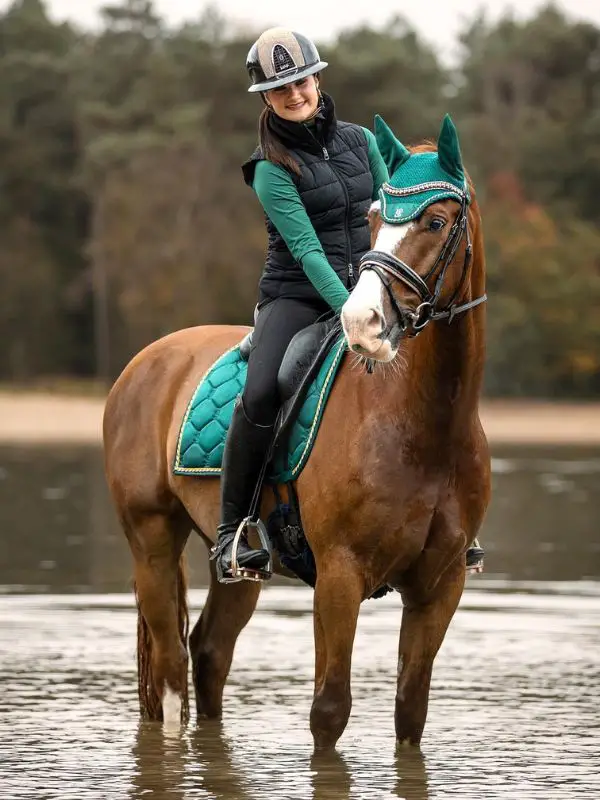The origin of equestrianism dates back to ancient civilizations where horse riding was practiced. Equestrian, derived from the Latin word “equester,” meaning “pertaining to a horse,” has its roots in the Greek, Persian, and Roman cultures.
Throughout history, humans have formed a deep bond with horses, appreciating their strength, speed, and agility. Ancient Greek cavalry soldiers known as Hipparchus were skilled equestrians, while the Persians pioneered chariot-driven warfare.
The Romans, renowned for their military prowess, used horse-mounted soldiers, known as equites, to gain an advantage in battles.
As time passed, equestrianism evolved beyond warfare to encompass various disciplines like racing, polo, and dressage, becoming a popular sport and a symbol of elegance and skill.
Today, the equestrian world continues to thrive, with enthusiasts worldwide participating in diverse equestrian activities.
Read More: Between an Equestrian And a Horse Rider
Historical Horse Domestication

The origin of equestrian can be traced back to the historical domestication of horses. Horses have been an integral part of human civilization since ancient times. They were initially used by humans for various purposes such as transportation, agriculture, and warfare.
The domestication of horses began thousands of years ago and has played a significant role in shaping different civilizations throughout history.
| Period | Significance |
|---|---|
| 4000-3000 BCE | The early domestication of horses was primarily used for transportation and pulling heavy loads. |
| 3000-2000 BCE | Horses become crucial for warfare, providing a military advantage. |
| 2000-1000 BCE | Horseback riding has become more common, expanding equestrian traditions. |
| 1000 BCE-500 CE | Horses continue to play a significant role in warfare and cavalry units. |
- Mesopotamia: Horses were utilized for chariots and mounted troops in ancient Mesopotamian civilizations like the Sumerians and Akkadians.
- Ancient Egypt: Horses were highly valued and used for transportation, royal processions, and warfare.
- Ancient Greece: The ancient Greeks relied heavily on horses in various aspects of their society, including transportation, agriculture, and military purposes.
- Rome: Romans used horses extensively for transportation, cavalry units, and chariot racing.
Equestrian Sports Evolution
Equestrian sports have a rich history that dates back thousands of years. From ancient warfare to modern competitions, the origin of equestrian activities can be traced to the earliest civilizations. The evolution of equestrian sports showcases the enduring bond between humans and horses throughout history.
Equestrian sports have a rich and fascinating history, tracing back to ancient times. The origin of equestrian can be found in the necessity of horseback riding for transportation, warfare, and hunting. It gradually evolved into a sport enjoyed by the nobility and the elite.
The ancient Olympic Games in ancient Greece played a significant role in popularizing equestrian sports. Horse racing and chariot races were prominent events during these games. The Romans, too, adopted these sports and introduced their own cavalry competitions.
Horseback riding also found its place across different cultures. In Asia, Mongolian and Japanese cultures heavily incorporated horsemanship in warfare and hunting. In Europe, equestrian skills were essential for knights and soldiers.
Today, we have a diverse range of modern equestrian disciplines, such as dressage, show jumping, eventing, and polo. These disciplines showcase the harmonious relationship between riders and their horses, highlighting the athleticism and beauty of both.
Equestrian sports have truly stood the test of time. From a necessity for survival to a noble sport, they continue to captivate people’s hearts and bring joy to riders and spectators alike.
Ancient Riding Traditions

The origins of equestrianism can be traced back to the first horseback riders, who existed in ancient times. These early riders developed unique techniques and used primitive equipment for riding and handling horses.
The first horseback riders emerged during prehistoric times when humans began to domesticate horses. Ancient civilizations such as the Sumerians, Egyptians, and Persians had a rich history of horsemanship.
In fact, the Sumerians are believed to have been the first to develop riding techniques and to use horses for transportation, hunting, and warfare. They used simple equipment such as bareback riding and basic riding aides like ropes and sticks.
| Techniques | Early Equipment |
|---|---|
| Bareback riding | Ropes and sticks |
| Basic riding aides | Leather saddles and bridles |
| Mounted archery | Simple bits and reins |
The ancient riders gradually improved their techniques and equipment over time. Leather saddles and bridles were introduced, providing more stability and control while riding.
Mounted archery also became a popular skill, requiring riders to shoot arrows while on horseback. Simple bits and reins were added to enhance communication between the rider and the horse.
Understanding the ancient riding traditions and techniques can provide valuable insights into the roots of modern equestrianism. The evolution of riding over centuries has shaped the sport into what it is today.
Global Expansion Of Horsemanship
Equestrian sports have a long and rich history that spans different continents and cultures. One of the key factors contributing to the global expansion of horsemanship was the Silk Road, a network of trade routes that connected the East and West.
The exchange of goods along these routes also included the trading of horses, which played a significant role in spreading equestrian practices.
Another major influence on the development of equestrian culture was the rise of cavalleria and European chivalry. Knights and nobles relied heavily on horseback riding for warfare and tournaments, further popularizing equestrianism across Europe.
The exploration and colonization of the New World brought horses to the Americas. Horse riding became an essential skill for cowboys, ranchers, and indigenous peoples, shaping the equestrian traditions in the Americas.
Medieval Tournaments To Modern Competitions
The origin of horseback riding or equestrian can be traced back to the medieval period. During this time, knights and noblemen would engage in various tournaments and competitions, showcasing their skills in horsemanship and combat.
Jousting was one of the most popular and iconic events of this era, where knights would charge each other with lances while riding on horseback. This daring sport not only tested their physical strength but also served as a symbol of honor and chivalry.
As time went on, equestrianism continued to evolve, giving rise to different disciplines and competitions. Horse racing emerged as a favorite pastime, becoming a formalized sport where thoroughbred horses would race against each other in a bid to reach the finish line first.
Another significant development in equestrianism was dressage, which originated from military training exercises. This disciplined art form focuses on the harmony between horse and rider, showcasing the horse’s ability to perform precise and controlled movements.
Breeds And The Shaping Of Equestrianism

Selective breeding has played a pivotal role in shaping equestrian sports, with specific breeds significantly impacting the development of this discipline. Through targeted breeding programs, horses have been selectively bred for sports, resulting in equestrianism becoming what it is today.
Breeds such as the Thoroughbred, known for its speed and agility, have greatly influenced horseracing. This breed’s exceptional ability to gallop at unparalleled speeds has made it an integral part of the racing industry worldwide. Similarly, the Akhal-Teke, known for its endurance and elegance, has left a lasting impact on long-distance riding competitions.
Additionally, the Warmblood, a versatile breed characterized by its athleticism and rideability, has been instrumental in various equestrian disciplines such as dressage and show jumping. Its adaptability has made it a popular choice among riders across different skill levels.
Overall, it is fascinating to observe how selective breeding has shaped equestrian sports, allowing for the emergence of distinct breeds that excel in specific disciplines. These breeds have not only enhanced the competitiveness of equestrianism but have also captured the hearts of enthusiasts worldwide.
Horseback Riding In Art And Literature
The origin of equestrian can be traced back to ancient times where horseback riding played a significant role in art and literature. Historical texts depict equestrianism as an important aspect of various civilizations, showcasing the shared fascination with horses and their riders.
Classical art beautifully captures the romanticism of horse riding, portraying the grace and power of equestrians through intricate brushstrokes and sculptures. These artistic representations not only highlight the skill of the riders but also provide insights into the cultural significance of horses in different societies.
From ancient Greek vases to medieval tapestries, equestrian themes have been woven into the fabric of human history, immortalizing the bond between humans and horses. This enduring presence of equestrianism in art and literature speaks to the timeless allure of horseback riding as a form of expression and recreation.
The Role Of Equestrian In Society
Horse riding has been an integral part of human society since ancient times. The origin of equestrian can be traced back to the early civilizations, where horses were primarily used for transportation, warfare, and hunting.
As societies evolved, horse riding became more than just a means of transportation. It grew to represent social status and wealth, with owning and riding horses being reserved for the elite class.
In today’s society, horse riding still holds a certain level of prestige. The social status associated with equestrian activities has not diminished over time. People who own and ride horses are often seen as refined and cultured individuals.
The exclusivity of horse riding as a recreational activity continues to attract enthusiasts from various social backgrounds.
Moreover, horse riding offers numerous physical and mental benefits. It promotes a sense of freedom, builds strength and flexibility, and improves coordination and balance.
Additionally, being in close proximity to these majestic animals can have a calming and therapeutic effect on individuals.
| Exclusive Activity: | Horse riding is an exclusive activity that continues to be admired and pursued by many individuals. |
|---|---|
| Social Status: | Owning and riding horses is often associated with wealth and prestige, reflecting an individual’s social standing. |
| Physical and Mental Benefits: | Horse riding offers a range of benefits, including improved physical fitness and a sense of emotional well-being. |
Technological Influence On Equestrian Sports
The origin of equestrian sports can be traced back to ancient times when horse riding was primarily used for transportation and warfare. However, with the advancement of technology, equestrian sports have evolved significantly.
Technological innovations have had a profound impact on the development of tack and gear, contributing to both safety and performance improvements.
| Developments in Tack and Gear |
| 1. Introduction of synthetic materials: The use of nylon, neoprene, and other synthetic materials in the production of tack and gear has led to enhanced durability, flexibility, and customization options. |
| 2. Innovative saddle designs: New saddle technologies such as adjustable gullets, panels, and treeless saddles provide better fit, comfort, and weight distribution for both horse and rider. |
Safety and performance equipment advances have also played a significant role in the modernization of equestrian sports.
1. Protective gear: The development of impact-resistant helmets, body protectors, and specialized riding boots has significantly improved rider safety during jumps, falls, and collisions.
2. Performance-enhancing equipment: From high-tech bridles with built-in pressure sensors to GPS tracking systems, equestrian athletes can now access valuable data and analytics to refine their training and performance.
Overall, technological innovations continue to shape the world of equestrian sports, providing riders with safer and more advanced equipment to excel in their disciplines.
Show Jumping And Its Origins
The sport of show jumping has a rich history that dates back centuries. Its origins can be traced back to European cavalry exercises which focused on training horses for combat. These exercises required horses to jump over obstacles, a skill that was vital on the battlefield.
Over time, these exercises evolved into competitive events known as “lepping” or “hunting at the bar” during the 18th and 19th centuries.
In the early 20th century, show jumping began to gain popularity as a standalone sport. The rules and regulations for the sport were established, and it became an Olympic event in 1912.
Modern show jumping competitions are governed by organizations such as the International Federation for Equestrian Sports (FEI).
Today, show jumping is a thrilling and popular equestrian discipline that showcases the grace, agility, and partnership between horse and rider.
The sport continues to evolve, with new techniques and equipment constantly being developed to push the boundaries of what horses are capable of.
Overall, the origins of show jumping lie in the traditions of European cavalry and the need for horses to navigate obstacles.
From its humble beginnings, show jumping has grown to become a widely recognized and beloved equestrian sport.
Dressage’s Artistic Expressions
The art of dressage, a key component of equestrian, has a rich history that spans centuries. While the origins of dressage can be traced back to the ancient Greeks, it was the Renaissance period that saw the development of the classical dressage style.
Classical dressage emphasizes the harmony between horse and rider, focusing on intricate movements and expressions of grace.
In contrast, the contemporary competition style of dressage has evolved over time to include more technical and precise movements.
Competitive dressage is now governed by specific rules and guidelines, emphasizing athleticism and accuracy.
Training techniques have also evolved over the years. Traditional methods involved years of patient and gradual training, building a strong foundation through basic exercises.
However, modern training techniques have incorporated advancements in equine science and a greater understanding of horse psychology. These techniques aim to develop horses more efficiently and effectively.
Overall, the evolution of dressage showcases the beauty and artistry of equestrianism, while also highlighting the importance of balancing tradition with the demands of contemporary competition.
Eventing: The Equestrian Triathlon
The origin of equestrian dates back to ancient civilizations where horses were primarily used for transportation, warfare, and agriculture. Equestrian is derived from the Latin word “eques,” which means horseman or knight. In modern times, equestrian has evolved into a popular sport that encompasses various disciplines, one of which is eventing.
Eventing is often referred to as the equestrian triathlon as it combines three different phases: dressage, cross-country, and show jumping. Each phase tests the horse and rider’s skills in different areas, highlighting the versatility and athleticism of both. Dressage focuses on precise movements and obedience, while cross-country tests the horse and rider’s bravery and endurance over natural obstacles.
Show jumping requires precision and agility to navigate a course of fences without knocking them down. It is fascinating to see how eventing has evolved from its ancient military origins into a thrilling and competitive sport today.
Endurance Riding: Testing The Limits
Equestrian sports have a rich historical significance, particularly in long-distance riding. The origins of endurance riding can be traced back to ancient times when people relied on horses to travel long distances.
The sport has evolved over the years, adapting to modern times and gaining popularity among horse enthusiasts.
In the past, long-distance riding played a vital role in military campaigns, with messengers on horseback delivering crucial messages.
Today, endurance riding has become a competitive sport, requiring both horse and rider to demonstrate their stamina and resilience.
With the advancement of technology, the sport has seen various changes. GPS technology and veterinary checkpoints have made it easier to track the progress of riders and ensure the well-being of horses.
Riders now have access to specialized equipment and training techniques to enhance their performance.
Overall, endurance riding has a deep-rooted historical significance and has successfully adapted to the demands of the modern world.
It continues to captivate horse enthusiasts, as they push the limits of their physical and mental endurance in this challenging yet thrilling sport.
Preserving Equestrian Traditions
Equestrian, derived from the Latin word “eques” meaning horseman, has a rich history that dates back centuries. Preserving equestrian traditions is not only about the sport itself but also about ensuring the cultural heritage and values associated with it endure.
Equestrian federations play a crucial role in this preservation process. These organizations, such as the Federation Equestre Internationale (FEI), are responsible for creating and enforcing rules and regulations that maintain the integrity of the sport. Through their efforts, equestrian traditions are upheld and the essence of the discipline remains intact.
In addition to the work done by federations, conservation efforts are essential in maintaining equestrian traditions. This involves safeguarding historic equestrian sites, promoting the protection of horse breeds, and supporting the preservation of traditional riding techniques and apparel.
By recognizing the importance of these aspects, we can ensure that equestrian traditions are passed down to future generations.
Preserving equestrian traditions is not just about the sport itself, but also about honoring its cultural and historical significance.
With the collaborative efforts of equestrian federations and conservation initiatives, these traditions can continue to thrive in the modern world.
The Future Of Equestrian Sports
In the world of equestrian sports, the future is filled with exciting developments and advancements. The industry is witnessing various trends in training and competition that are transforming the way horses and riders prepare and compete.
One of these trends is the integration of technology into equestrianism. Innovations such as GPS tracking devices, biomechanical analysis, and virtual reality training simulations are revolutionizing how riders train and improve their skills.
Another trend is the emphasis on horse welfare and ethical training practices, with a growing focus on positive reinforcement and natural horsemanship. Additionally, equestrian sports are expanding globally, with new competitions and disciplines emerging in different parts of the world.
These trends, combined with ongoing efforts to promote inclusivity and diversity in the sport, are paving the way for a promising future for equestrianism.
Final Thoughts
The origin of equestrianism traces back to ancient civilizations, where horses played a crucial role in transportation, warfare, and sport. From the nomadic tribes of Central Asia to the Renaissance era and beyond, the bond between humans and horses has been enduring.
Understanding the history of equestrians allows us to appreciate the profound influence these majestic creatures have had on our culture and society. Exploring this rich heritage nourishes our connection with horses, fueling our passion for equestrian pursuits.